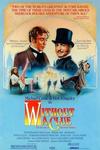
© Amazon.fr
First volume of The Baroque Cycle by Neal Stephenson, divided into
three books.
Quicksilver
1713. Daniel Waterhouse is convinced by Enoch Root to leave Massachussets and
return to England to defuse a conflict between supporters of Leibnitz and
those of Newton as who invented calculus. While his ship is under attack by
pirates, trying to leave the coasts of Massachusets, Daniel remembers his
youth from 1661 to 1673. Daniel has met Isaac Newton at Cambridge and, while
Newton was completely absorbed by his research, prevented him from dying by
forcing him to eat and sleep. During the Plague, he fled to the countryside
where he met members of the Royal Society and studied with them on various
topics. Later he returned to Cambridge, became a Doctor and a fellow of the
Royal Society. Daniel witnessed or was involeved in several political plots
during this period: he was delivering mail from Huygens to Henri
Oldenburg, secretary of the Royal Society for foreign correspondonance and
prisoner at the Tower of London under suspicion of exchanging by means of
these letters secret messages with foreign states; the Comstock family was
supplying the English Navy with cannons and powder, and was discredited and
ruined after cannons exploded because they were loaded with pre-packed powder
that was ground too fine (the bad powder was planted by a political rival);
the creation of the Bank of England, independent from the King, after the
latter ruined several goldmiths by taking the gold entrusted to them by their
customers. In the background, there were wars between England and the Dutch
who were allied to France during the first war, but since King Charles II is
suspected to be a catholic pretending to be anglican, England was allied to
France in the second one.
King of the Vagabonds
1683. Jack Shaftoe is a Vagabond, occupying himself by being a footman in the army
of Poland-Lithuania, going to attack the Turks who are assieging Vienna. While
all the fighting is done by the cavalry, Jack saves Eliza, a yound Qwghlmian
woman who is a slave in the the harem of the Grand Turk. Together they travel
through Europe to Leipzig where they meet Leibniz, and eventually arrive in
Amsterdam where Eliza shows great skill at investing the stock market. This
sedentary life doesn't suit Jack who travels to Paris to deliver a letter from
Eliza to a banker. Jack then tries to make money for himself by selling
ostrich feathers and his horse, both stolen from the Turks at the siege of
Vienna, but is instead taken prisoner by the Duc d'Arcachon. John Churchill,
for whom Jack and his brother Bob had been couriers earlier in their life,
helps him escape to prevent Jack from inadvertantly telling things about
Churchill when being tortured. Jack thus escapes and accidentally discovers
that d'Arcachon is the eater of rotten fish who had taken Eliza and her mother
as slaves many years ago. Meanwhile, Eliza is introduced to the the court of
the King William of Orange by d'Avaux, the French ambassador. With another
Englishman, they plot to influence the market and make a lot of money. On his
way back to Amsterdam, Jack becomes partner in a business operation, which was
promised to make him rich. But when he sees Eliza again and tells her about
it, she understands that the operation is a slave trade. Since Jack wants to
continue with the operation because he invested all he had in it and doesn't
want to depend on Eliza's money, she tells him she doesn't want to see him
ever again. Jack's ship leaves Amsterdam, but Jack is made prisoner by pirates
near Africa and becomes a slave himself. Eliza leaves for Versailles to become
a spy for d'Avaux at the court of King Louis XIV, but on the boat she is
convinced by William of Orange, an ennemy of Louis XIV, to become his spy in
exchange for the title of Duchess of Qwghlm when he becomes king of England.
Odalisque
1685. Eliza is working as a governess for some noble at Versailles, and
reporting to d'Avaux, d'Orange and Leibniz. In London, Daniel Waterhouse
witnesses the death of Charles II. The next king is James II, openly a
catholic. Since Eliza is handling the money of many French nobles, she becomes
slowly more important at the court. She travels from time to time to
Amsterdam, where she meets William of Orange and lives at Huygens's house.
There she meets Bob Shaftoe who wants her to help him recover a
protestant girl he fell in love with and who has been sold as a slave to an
English noble, now Chief Justice of the King. In 1687, Daniel travels to
Amsterdam to meet William of Orange, the so-called Defender of the
Protestants, and prepare what will be later called the Glorious Revolution
i.e., William of Orange becoming King of England without bloodshed. Daniel
also meets Eliza during a dinner at Huygens's house. The next morning they
prevent the abduction of William by French dragoons, a plot that was rumored
about in various circles. Back to Versailles, Eliza is made Countess de la
Zeur by the King. Daniel on the other hand is threatened by catholic nobles
(including the Chief Justice) and eventually made prisoner at the Tower of
London and awaiting to be assassinated (since he cannot officially be tried).
But Daniel is protected by Bob Shaftoe, who happens to replace the guard at
the Tower. Meanwhile, Eliza is fleeing Versailles with the help of Liselotte
von der Pfalz, sister in law to Louis XIV, motivated by the fact that the king
is invading her country. After being arrested by French troops in Lorraine,
Eliza sleeps with the son of d'Arcachon who is leading those troops and
eventually reaches Amsterdam and Hyugens's house. The story of her journey is
known to Louis XIV because Eliza kept an enciphered diary which was stolen a
Huygens's house and decrypted by Bonaventure Rossignol, cryptanalyst of the
king. In 1688, James II flees London and William of Orange becomes the new
King of England. Daniel and Bob get the Chief Justice, who also fled from
London, to get lynched by a crowd for the exactions he had commited on the
people many years earlier. Finally, Eliza gives birth to a son in Amsterdam.
D'Arcachon believes the baby is his (and since d'Arcachon carries a genetic
defect, he is eager to get his hands on a son that hasn't got this defect) and
tries to steal it but fails. But in a letter to Leibniz, Eliza tells that the
father is really Rossignol, whom she had met in Versailles and happened to be
in Lorraine while she was there.















